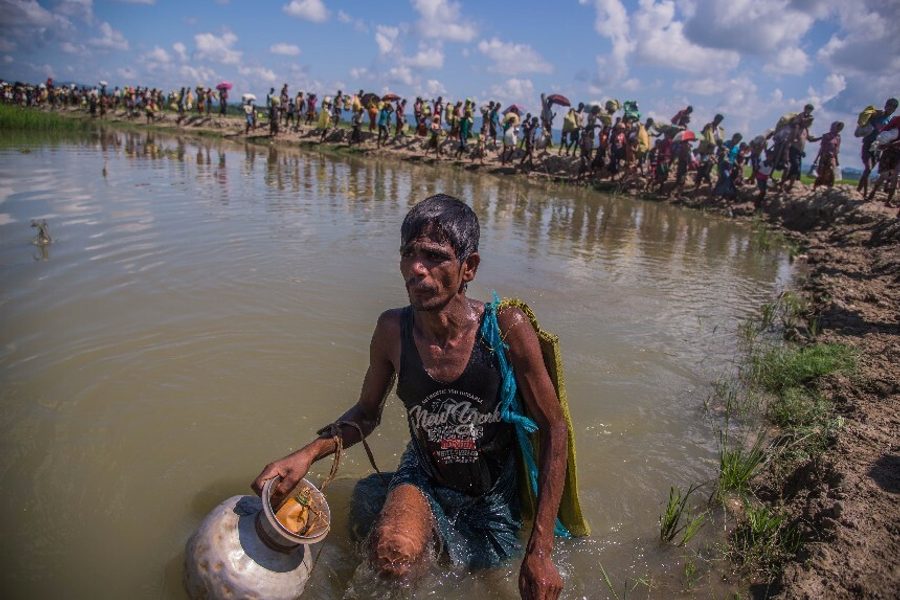In Myanmar, “Anti-Terrorism” Is Cover for Ethnic Cleansing
A brutal state crackdown against the long-persecuted Rohingya minority has created a humanitarian crisis.
Amar Diwakar

On August 25, the Arakan Rohingya Salvation Army (ARSA) — a fledgling insurgent group in conflict with the Myanmar government—attacked multiple border police posts in the western state of Rakhine and killed 12 officers. In response, Myanmar’s security forces launched a bloody campaign against the country’s embattled Rohingya community, a campaign that has killed more than 1,000 people, according to the UN Special Rapporteur on Human Rights for Myanmar.
A month since the crackdown, it is estimated that close to half a million Rohingyas, a Muslim minority in the majority-Buddhist state, have fled the army’s brutal offensive into neighboring Bangladesh. The number of Rohingya who have taken transnational sanctuary surpasses even the worst month of the Syrian war’s refugee crisis. Amnesty International indicts the military for sanctioning a scorched-earth operation replete with extrajudicial killings, systematic rape and wanton murder of children. Satellite imagery from Human Rights Watch shows the incineration of entire villages.
UN human rights chief Zeid Ra’ad Al Hussein says what is transpiring “seems a textbook example of ethnic cleansing.” UN secretary general Antonio Guterres has called on Myanmar authorities to cease military operations, calling the crisis “the world’s fastest developing refugee emergency and a humanitarian and human rights nightmare.” Yet the government defends itself by claiming to be combating terrorism as justification for launching clearance operations in what has amounted to be an indiscriminate crackdown on civilians.
In Myanmar — a fractious, underdeveloped, multi-ethnic country beset by several insurgencies — the Rohingya inhabit an exceptional status of neglect and abuse. Living in squalor and apartheid-like conditions in Rakhine, the 1.1 million Rohingya rank as one of the world’s most persecuted minorities; state-sponsored repression of the group has persisted for decades.
Myanmar’s ruling authorities have long endorsed a racialized conception of ethnicity, and officially recognizes 135 ethnic groups (those that allegedly lived within the country’s boundaries before the 1824 British invasion). Since the 1962 coup, the state machinery has assumed the role of arbitrator, regulator and enforcer of collective identities. A stark example is the ID cards that all citizens are obliged to carry, which state both their ethnicity and religion — two intertwined categories that to a large degree determine one’s place in the country. As such, those adjudicated as “belonging” to the Burmese polity are exclusively defined on identitarian grounds, as other groups are subordinated in a hierarchy dominated by the Burmese-Buddhist majority.
It is then telling that the Myanmar state does not consider the Rohingya as a legitimate part of its socio-political order. Following independence from the British in 1948, the Union Citizenship Act was passed, defining which ethnicities could gain citizenship. The Rohingya were excluded. (It did, however, allow those with families living in the country for at least two generations to apply for ID cards.) With the passing of the 1982 citizenship law, the government rendered the Rohingya stateless. Effectively barred from legal recognition as one of Myanmar’s 135 ethnicities, they were excluded from even the basic level of naturalized citizenship because the appropriate paperwork had been denied to them by previous regimes. As a result, their rights to work, education, travel, marriage, and access to health care have been and continue to be severely restricted.
Since then, the state has mounted intermittent, military-led campaigns to effectively purge the Burmese body politic of a people officially deemed by the government to be “Bengalis,” implying that they are illegal immigrants from Bangladesh — despite their presence in the region for generations — to foment their erasure. At the same time, state authorities vehemently reject the term “Rohingya” itself as a recent invention, created for political reasons to legitimize a foreign contagion.
In 2015, the opposition National League for Democracy (NLD) — led by Aung San Suu Kyi — secured the country’s first electoral victory in decades, ushering in a seven-step roadmap to democracy, referred to as “discipline-flourishing democracy,” after a half-century of dictatorship. The transition, carefully managed by the military brass, has been relatively smooth, and despite tensions between the NLD and the military, they managed to foster a power-sharing arrangement.
But this (partial) political liberalization would not bring about any substantial improvement in the Rohingya’s plight. The army remains constitutionally separated from civilian oversight and retains control of key ministries. It has every incentive to keep ethnic tensions simmering so it can peddle itself as a national security buttress against external threats.
The NLD’s response to the last month’s bloodshed has been tepid. International outcry has aimed at the silence of Suu Kyi, rife with calls from editorials, columnists and fellow laureates to rescind the Nobel Peace Prize awarded to her in 1991 for non-violent struggle to secure democracy and human rights in the country.
Given that the NLD lacks the organizational cadres of a mass party and relies in part upon the popular mobilization of Buddhist monks, it has been reluctant to confront extremist Buddhist groups that have been at the vanguard of provoking antagonism against the Rohingya such as Ma Ba Tha, a prominent ultra-nationalist and anti-Muslim grassroots outfit. It is evident that the party also fears challenging the army’s daunting institutional strength.
The Rohingya’s predicament also stems, in part, from the “war on terror.” Given the appalling barbarism the Myanmar state has inflicted on them, it shouldn’t be a surprise that some Rohingya would turn to militancy — what eventually became known as ARSA, an internationally bank-rolled, ragtag insurgency of a few hundred fighters trained in guerrilla war tactics.
The Myanmar government uses ARSA as evidence of Islamic extremism embedded within the Rohingya, casting them as a sinister threat to the security of the Buddhist majority, while treating Rohingya men as potential terrorists and blocking humanitarian aid in the process. It’s a tactic used by the U.S. state abroad and more recently by the Assad regime in Syria: tarring opponents as extremists while inflicting war crimes upon hapless civilians.
This all has a familiar ring to it. By using disproportionate force that has driven hundreds of thousands from their homes, the government risks fostering conditions for further radicalization that transnational jihadists will readily exploit.
Devoid of protracted international pressure to enforce a ceasefire, Myanmar authorities have little reason to curb their onslaught. And even once hostilities subside, any sustainable long-term solution must involve an overhaul of Myanmar’s exclusionary citizenship law. The Rohingya must be afforded the basic right to exist in the country — a country that otherwise sees fit to exterminate them from its collective memory.

I hope you found this article important. Before you leave, I want to ask you to consider supporting our work with a donation. In These Times needs readers like you to help sustain our mission. We don’t depend on—or want—corporate advertising or deep-pocketed billionaires to fund our journalism. We’re supported by you, the reader, so we can focus on covering the issues that matter most to the progressive movement without fear or compromise.
Our work isn’t hidden behind a paywall because of people like you who support our journalism. We want to keep it that way. If you value the work we do and the movements we cover, please consider donating to In These Times.




